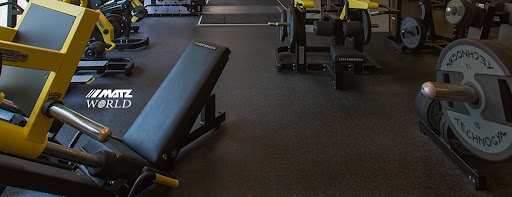
Are you setting up a home gym or a commercial gym? To have a functional gym you must be wondering which flooring to use. There are so many factors to consider – the aesthetics, the safety, the comfort. Everything has to be perfect. With many types of gym mats to choose from, this might seem like a challenging task. And we have made this guide to take away that challenge. We have broken down the various options available and the factors to consider as you make this important choice.
Types of Gym Mats
- Rubber Gym Mats
Rubber mats are the most popular type of flooring for gyms. The durability, shock absorption, and water resistance that it offers make it one of the best mats available. Rubber gym mats usually come in two forms:
- Interlocking Tiles – These mats offer flexibility, allowing you to rearrange as per your need. These are ideal for home gyms. Typically, a good gym flooring supplier in Dubai will provide interlocking tiles in the format of puzzle pieces and straight-cut tiles.
- Rubber Rolls – These continuous, seamless rolls minimize the risk of tripping. If you have a large area to cover, rubber rolls might be the best choice.
- Vinyl Flooring
For individuals seeking design freedom, vinyl flooring is a fantastic option even though it isn’t as robust as rubber mats. You get more options with versatile designs and patterns. Other advantages include water resistance and cost-effectiveness.
- Laminate Flooring
Laminate flooring is cost-effective and has the aesthetic appeal of wood flooring. It is also resistant to scratches and stains. However, it is not as shock-absorbent as rubber.
- Foam Flooring
Foam flooring offers moderate shock absorbance and is available in various thicknesses and colors. This type of flooring is also easy to install and quite affordable.
- Carpet Tiles
Carpet tiles provide considerable sound absorption and are available in a range of colors. Although the water resistance is low, these tiles make for a good choice for low-impact exercises.
As you have seen, there are quite a few options available. If you prefer aesthetics you might be interested in laminate flooring. However, if safety and ease of maintenance are your priority, rubber flooring is the best choice.
Factors to Consider When Choosing the Perfect Gym Mat
You should keep some factors in mind when you are choosing between the many flooring options available. This will ensure that you are picking the right option that fits all your needs. The following are some of the key factors to consider:
1. Cost
Pick a gym mat that fits your budget. Be sure to factor in the cost of installation and maintenance costs while you are calculating the total expenses. For example, a rubber flooring mat might be more expensive than vinyl but the maintenance costs are lower for rubber mats. So always think long-term as you calculate the expenses.
2. Installation
Select easily installable interlocking rubber matting if you would rather do the flooring yourself. Alternatively, you can select any of the other flooring options if you don’t mind hiring an expert.
3. Durability
Always consider the durability of the mats you buy. This will determine the expense you will incur in the form of maintenance costs in the long run.
4. Sweat Resistance
Always choose a mat that is sweat-resistant. Perspiration can build up in a busy gym, therefore a sweat-resistant mat will stop moisture absorption and stop microbiological growth.
5. Movement of Traffic
Select flooring for your gym that is appropriate for the volume of traffic it will see. If you’re using it as a personal home gym, you might want to look into thinner options. Conversely, if you want the best flooring for a gym with a lot of traffic, invest in a thicker rubber mat.
6. Thickness
Select the thickness based on your requirements:
- ¼ Inch or 6mm – The thinnest choice is ¼ inch or 6mm. Excellent for regions with a lot of traffic, but not advised for gyms.
- ⅜ Inch or 10mm – Optimal for cardio equipment such as treadmills.
- ½ Inch or 13mm – Choose this if you are weight training regularly. This thickness also offers sound absorption.
- 1-inch or 25mm – 1-inch thick flooring is ideal for professional powerlifters who tend to drop weights. These mats offer great protection for your flooring.
7. Noise Absorption
High-impact exercises generate distracting noises. This can be solved to an extent by using mats with noise absorption quality.
8. Space to Cover
Consider the amount of space you would need to cover with the mats. If you have a large area to cover, rubber rolls might be the best option.
FAQs
- Can rubber mats get wet?
No, rubber mats don’t get wet. They are water resistant.
- How to clean rubber gym mats?
You can vacuum your gym mats and easily keep them clean. Alternatively, you could wipe the mat with a damp cloth and allow it to air dry.
- Are rubber floor mats safe?
Yes, rubber mats are non-toxic and safe.
- What are the benefits of using rubber gym mats compared to other options?
Durability, shock absorption, slip resistance, and ease of maintenance are a few advantages of rubber matting.
- Are rubber mats suitable for home gyms?
Because they are durable, simple to install, and easy to clean, rubber gym mats are a great option for home gyms.
Conclusion
From the highly durable rubber to the aesthetically pleasing laminate, our guide has unpacked the various types of gym mats available. Consider the key factors like budget, installation ease, durability, thickness of the mat, and sweat resistance as you make your choice. If you value durability and shock absorption, buy rubber gym mats. For design options choose vinyl and for low-impact exercises choose foam flooring. The ideal gym mat will combine functionality and safety, allowing you to have a great workout session.